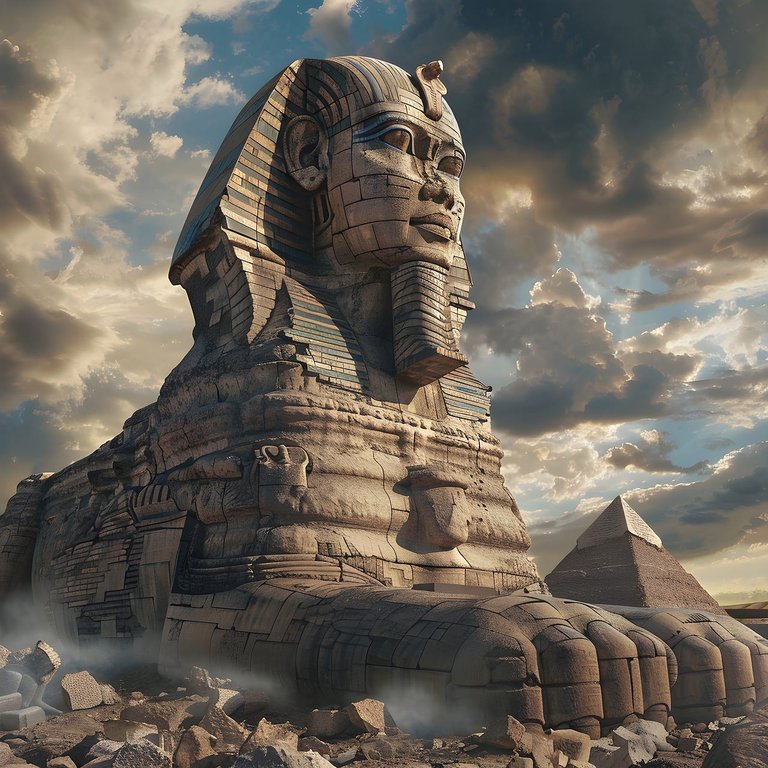The Pyramids and the Sphinx — Technology Beyond Time

They rise from the sands like timeless sentinels, etched into the skyline of human consciousness: the Great Pyramids of Giza and the stoic, enigmatic Sphinx. These monuments are not merely the pride of Egypt — they are riddles in stone that have perplexed archaeologists, engineers, and mystics for centuries.
While mainstream history tells us they were built around 2500 BCE by a well-organized workforce of ancient Egyptians, growing evidence suggests something far more extraordinary. What if these iconic structures are remnants of a forgotten civilization? One far older than Egypt itself, and perhaps influenced by the same sky beings that inspired the myths of Sumer and the Egyptian pantheon?
A Monument Without a Name
The Great Pyramid of Giza, attributed to Pharaoh Khufu, bears almost no markings inside. Unlike the richly decorated tombs in the Valley of the Kings, it contains no inscriptions proclaiming ownership, no records of construction, and no bodies. This absence of evidence leads many to wonder: was it ever a tomb at all?
Add to that its mind-boggling precision. The base of the Great Pyramid is level to less than an inch. It is aligned almost perfectly to the true north. The structure incorporates advanced mathematics, including pi and the golden ratio, and encodes the dimensions of the Earth within its proportions. How could a Bronze Age civilization achieve such precision? Modern architects and engineers have admitted that replicating the structure today with such accuracy would be incredibly difficult, even with contemporary equipment.
Stargates of Stone
The pyramids are not randomly placed. Their layout mirrors the stars of Orion's Belt — a constellation deeply associated with Osiris, the Egyptian god of the afterlife. This celestial alignment suggests the builders had sophisticated astronomical knowledge.
The same alignment appears in ancient sites across the globe — in Teotihuacán, Mexico, and the ancient city of Xi'an in China. Could this be evidence of a shared legacy from a global civilization? Or a common source of knowledge given to these disparate cultures by the same mysterious beings?
The Sphinx: Older Than We Think?
Even more controversial is the Great Sphinx. Conventional dating places its construction around 2500 BCE, during the reign of Khafre. But some geologists, such as Dr. Robert Schoch, argue that erosion patterns on the Sphinx show signs of prolonged water exposure — suggesting it may be over 10,000 years old.
This would place its origin well before the accepted dawn of Egyptian civilization and into the realm of prehistory. Perhaps even into the same time frame that Plato assigned to Atlantis. Who carved the Sphinx, and why does it face the rising sun with such regal defiance? Is it the last memory of a forgotten time, a lone guardian of knowledge left behind by a civilization lost to myth and sand?
A Technology We Can’t Explain
Speculation surrounds the purpose of the pyramids. Were they power plants, giant harmonic resonators, astronomical observatories, or even stargates? The King's Chamber resonates at specific frequencies, and some claim electromagnetic anomalies exist within the structure.
There is no definitive answer. But the pyramids were not just tombs. They were machines of some kind — tools built with purpose and precision.
If the Anunnaki, or another advanced race, shared their knowledge with early humans, the pyramids might be the last functional relics of that exchange. They may not only tell us about Egypt but also about an era when humanity was guided by beings who came from beyond the stars.
Echoes of a Forgotten World
The mysteries of the pyramids and the Sphinx whisper to us across millennia. They defy conventional timelines, suggest impossible precision, and carry within them the echoes of a deeper story — one we are only beginning to piece together.
Could they be monuments left behind by survivors of a lost world like Atlantis? Could they be beacons built under the guidance of sky gods who once walked among us? And more haunting still — what if those beings never left?
Next Up: Atlantis — Lost Civilization or Forbidden History? Plato’s account might not be fiction at all. Let’s explore the evidence that this sunken world seeded the great civilizations of the ancient world… and left behind clues hidden in plain sight.
Posted by Waivio guest: @waivio_cosmicsecrets